Of all the 639 bird species reported from Texas, only one is endemic, meaning it nests nowhere else in the known universe except within the borders of that one state. That endemic species is the critically endangered Golden-cheeked Warbler, first discovered by ornithologists in 1860 on its wintering grounds in Guatemala, which is also where I first saw the species, in early 2007. The Golden-cheeked Warbler’s nesting grounds in the hill country of central Texas were discovered four years later, in 1864. This elegant warbler breeds in old-growth and mature regrowth juniper-oak woodlands in limestone hills and canyons, and is reasonably common in what once been the dominant habitat of that area of Texas. Increasing urbanization and land clearing for agriculture put the habitat in dire jeopardy, justifying the bird’s listing as Endangered by the US Fish and Wildlife Service in 1990.
After I added my lifer Colima Warbler in Big Bend on July 21, I suddenly had the desperate urge to see the only remaining North American warbler I’d never seen in the United States, so when I left the Big Bend area, I headed straight to Balcones Canyonlands National Wildlife Refuge near Austin. I arrived a bit after 5 pm on July 23, a half hour after the refuge headquarters had closed, and so tried to find the Warbler Vista area on my own. I drove on the highway that circles the refuge, and after what seemed like a long drive, I passed a church on the refuge side of the road so figured I must have missed it. I went back to the headquarters entry to study the map some more, right as a woman pulled up to enter the code to open the locked gate. I asked for directions, and she said the Warbler Vista was not far beyond that church. I drove back and found the entrance about 5:45 or so. The gravel road up to the vista was rough and steep, and my car was skidding and struggling when a bird flew right in front of me. It had golden yellow cheeks, black wings, and a lot of white in the tail. A Golden-cheeked Warbler! I’d have stopped and tried to find and photograph it, but was having too much trouble negotiating the hill even as I kept moving steadily along.
The temperature was still over 100 degrees when I made it to the parking area, closed up the car, and started my hike on the Cactus Rocks Trail, which is one and a quarter miles through prime Golden-cheeked Warbler habitat. Immediately I saw a gorgeous male Golden-cheeked Warbler—not in the flesh, but painted on a rock with the number one. The trail had at least 16 of these markers, each numbered and showing a bright painted image of the Golden-cheeked Warbler. A pamphlet gave information about plants, animals, or ecological events that had taken place around each marker.
By late July, virtually all songbirds have finished the territorial phase of their breeding cycle, so songs are few and far between. I was at Balcones Canyonlands late in the afternoon, when fewest birds sing even during the height of territoriality, and it was a hot day to boot. The only sounds I heard on the entire hike were a distant Tufted Titmouse, the wind, and branches colliding in the wind. The only birds I saw, other than the ones painted on those markers, were Turkey Vultures passing repeatedly over and looking down on me hopefully as I roasted in my own juices.
I’d seen the warbler along the road well enough to count—I’d noted all the field marks—but after a similar brief, unsatisfying look at the Colima Warbler, I felt disappointed as I headed back to the parking lot. Suddenly, right in front of me came an adult male Golden-cheeked Warbler and two fledglings. Pairs split up when their chicks leave the nest, each taking part of the brood. Young remain with a parent until they are independent, 4 weeks or more after fledging. I was apparently seeing the male’s half of one little family. He gave me a few brief photo ops, and I took some fair pictures of both chicks. I was thrilled.
Balcones Canyonlands is one of the many national wildlife refuges with absolutely no fees to enter. I purchase at least a couple of Duck Stamps every year, knowing that 98 cents of every dollar I spend goes directly to habitat acquisition by the national wildlife refuge system. But I’m going to make a special donation to Balcones Canyonlands because research being done here and splendid habitat management are essential in the struggle to save this splendid bird.


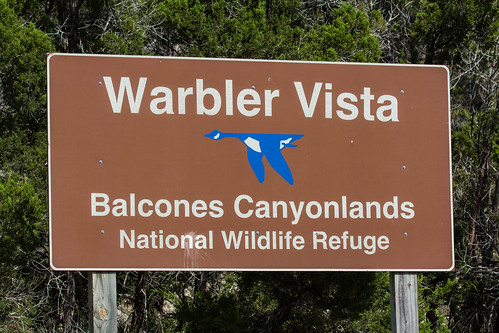
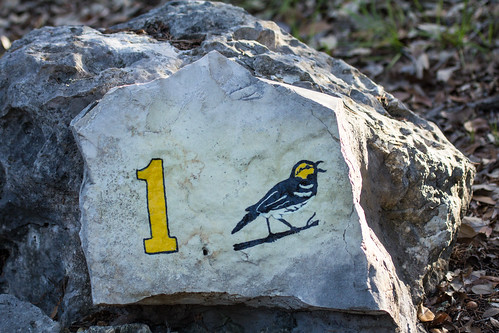
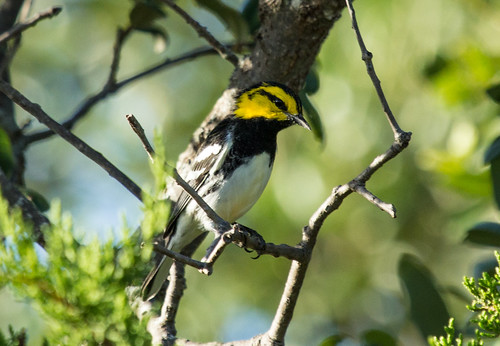
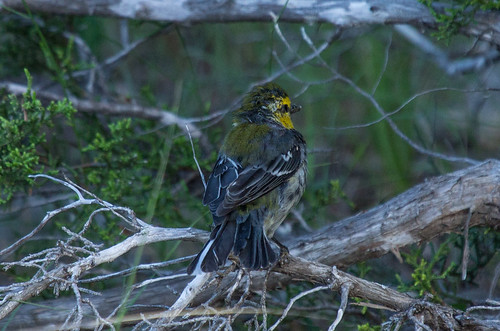
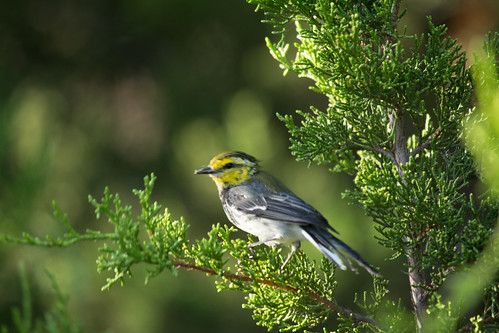
I enjoyed both your Colima & Golden-cheeked warbler searches. I hope to go to Big Bend Nat. Park someday, but more likely in April/May. Wow a mtn. lion! What a hike that was.
Mike – Elkton, Va.